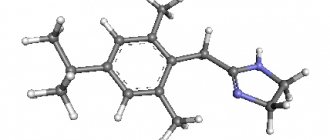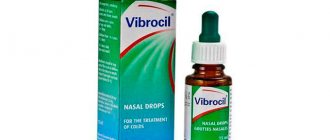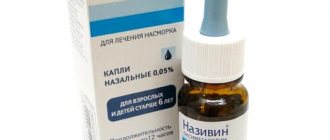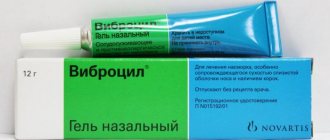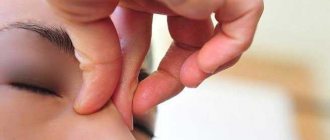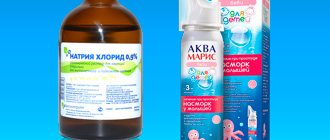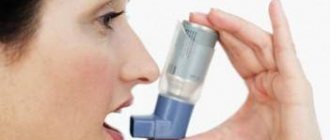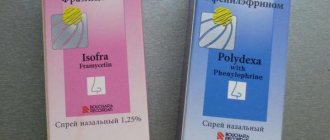The nasal remedy Vibrocil is presented in three dosage forms - drops, spray and gel. Thanks to this choice, the patient can acquire a form that is more convenient for him.
Country of origin: Switzerland. Vibrocil is a reliable helper against allergic rhinitis, and will also be indispensable for conditions accompanied by nasal congestion.
Unfortunately, Vibrocil is not used in pregnant women and during lactation, due to the vasoconstrictor component.
In pediatric practice, Vibrocil is allowed for use from the infant period (drops), gel and spray are indicated only after the age of six. There are cases when Vibrocil is not tolerated by patients, then substitute drugs (analogs) should be selected. Patients often ask the doctor to find cheaper analogues if the price of Vibrocil does not suit them.
The cost of vibrocil ranges from 260 to 300 rubles, in ascending order of price you can make a list: gel, drops, spray.
Operating principle
In otolaryngology, vibrocil is especially popular. The drug eliminates the development of a chain of allergic reactions, relieves inflammation, swelling, and improves nasal breathing. It also helps prevent the development of otitis media in children (nasal congestion in childhood is a common cause of inflammatory ear diseases).
Phenylephrine reduces swelling of the nasal passages and sinuses. The substance has a moderate vasoconstrictor effect and is classified as a sympathomimetic.
Dimetindene maleate fights allergies and all its manifestations; it is a blocker of histamine H1 receptors.
Action of Nazivin
This is a drug with a vasoconstrictor effect. Available in the form of spray and drops. The active ingredient is oxymetazoline hydrochloride. Thanks to the medication, swelling of the inflamed nasal mucosa is reduced, nasal breathing is normalized, the amount of discharge is reduced and the likelihood of complications is prevented.
Nazivin, when used in therapeutic doses, does not have a systemic effect and does not irritate the mucous membranes. The effect of the drug begins 10 minutes after administration and lasts up to 12 hours. The medication is approved for the treatment of even infants, and during pregnancy it is used strictly as prescribed by the doctor.
- respiratory diseases that are accompanied by rhinitis;
- vasomotor rhinitis;
- otitis media;
- to get rid of swelling in the nasal passages before diagnostic procedures;
- allergic rhinitis;
- sinusitis;
- Eustachitis.
- angle-closure glaucoma;
- atrophic rhinitis;
- intolerance to the components of the drug.
Nazivin, when used in therapeutic doses, does not have a systemic effect and does not irritate the mucous membranes.
With caution, the medication should be taken simultaneously with MAO inhibitors, with increased intraocular pressure, diabetes mellitus, thyrotoxicosis, angina pectoris, arterial hypertension, and lactation.
Taking Nazivin can lead to the following negative reactions of the body:
- burning sensation and dryness of the nasal mucosa, sneezing, feeling of nasal congestion;
- nausea;
- headache, fatigue, insomnia, anxiety;
- tachycardia, arterial hypertension.
Contraindications
The following cases are considered prohibited from using Vibrocil:
- individual intolerance to the composition of the drug;
- Vibrocil is prohibited in pediatrics under 6 years of age (spray and gel form);
- atrophic runny nose;
- ozena;
- pregnancy and breastfeeding.
There are also relative contraindications, these include:
- dizziness;
- sleep disturbance;
- angle-closure glaucoma;
- hypertension;
- heart rhythm disturbance;
- endocrine pathologies;
- diabetes (insulin dependent);
- hyperplastic processes of the benign prostate gland.
Nazivin and Vibrocil - what is the difference?
To understand how these drugs for topical use differ, you need to familiarize yourself with their composition and principle of action. Despite the same indications for use, Nazivin and Vibrocil have significant differences in contraindications, which must be taken into account when choosing.
Compound
The active ingredients of Vibrocil are:
- Phenlylephrine is a substance from the group of sympathomimetics that constricts blood vessels by acting on their receptors.
- Dimetindene is an antiallergic compound that blocks receptors responsible for the development of an allergic reaction.
Nazivin contains only one active component - oxymetazoline. It is a vasoconstrictor that acts locally, only at the site of application, without entering the bloodstream.
Mechanism of action
- Phenylephrine in Vibrocil has a vasoconstrictor effect. As a result, blood flow to the mucous membranes is reduced, swelling and mucus production are reduced. Dimetindene enhances the effect due to its antiallergic properties.
- Nazivin also belongs to the group of vasoconstrictor drugs. When applied topically, it narrows the capillaries, reducing swelling of the nasal mucosa and paranasal sinuses. At the same time, it does not cause irritation and does not cause redness.
Indications
Nazivin and Vibrocil have the same indications for use:
- acute rhinitis (runny nose) caused by colds;
- vasomotor rhinitis, the cause of which is a violation of vascular tone;
- runny nose of allergic origin;
- chronic rhinitis;
- sinusitis (inflammation of the paranasal sinuses);
- acute otitis media - inflammation of the ear;
- preparation for nasal surgery and reduction of swelling in the postoperative period.
Contraindications
Vibrocil should not be used for treatment in the following cases:
- intolerance to the components of the drug;
- atrophic rhinitis is a specific type of inflammation of the mucous membrane, in which it becomes thinner;
- pregnancy;
- breastfeeding period;
- age up to one year;
- simultaneous use of antidepressants of the MAO inhibitor group and the first 2 weeks after their withdrawal.
Contraindications to the use of Nazivin are:
- hypersensitivity to its components;
- angle-closure glaucoma – increased intraocular pressure;
- atrophic rhinitis.
Side effects
Nazivin rarely causes negative reactions in the body; isolated cases have been reported:
- dry mucous membranes, sneezing;
- feeling of nasal congestion;
- nausea;
- headache;
- insomnia.
Vibrocil may cause side effects such as a burning sensation and dry nose.
Nazivin is available in the form of a spray and drops in 10 ml bottles with different concentrations of the active substance:
- drops 0.025% - 142 rubles; 0.01% - 159 rubles;
- 0.05% - 148 rubles;
- 11.25 mcg/dose – 179 rubles;
The Swiss drug Vibrocil is produced in the form of drops, gel and spray. In pharmacies you can buy drops in a 15 ml bottle for 283 rubles.
The drugs have different main components, but they have the same effect - they narrow the vessels of the nose. Thanks to this, blood does not rush so much to the mucous membrane, swelling is eliminated, and mucus production is reduced. The medications have identical indications for use, and they rarely cause side effects. Vibrocil has more contraindications. Nazivin is available in the form of a spray, gel and drops, and Vibrocil is available only in the form of a spray and drops.
How to use vibrocil - dosages
In order for the drug to have the desired effect, before administering the drug, it is recommended to clean the nasal passages with saline solutions, i.e. Rinse your nose thoroughly to remove crusts and mucus.
Drops are instilled into the nose with the head thrown back. Dosage regimen – 3-4 times a day. Dosages for age groups are as follows:
- from birth to 1 year – 1 drop in each nasal passage;
- from 1 year to 6 years – the dose can be increased to 2 drops in each nostril;
- for all other patients, the dose of Vibrocil ranges from 1 to 4 drops, depending on the doctor’s prescription.
The spray, according to the instructions, should be injected 1-2 doses up to four times a day. The gel, like the spray, is used 3-4 times a day. It should be inserted as deep as possible into the nasal passages.
Important! Vibrocil is not recommended to be combined with beta-blockers, drugs to lower blood pressure, or tricyclic antidepressants.
We recommend that you read the detailed instructions for vibrocil for a runny nose.
Contraindications to the use of products
"Vibrocil" should not be used for therapy in the following cases:
"Nazivin" is contraindicated for use in the following situations:
Vibrocil - analogues (list)
So, if vibrocil is not suitable, the following remedies can be offered as a replacement:
- nazol advance;
- adrianol;
- eucazoline;
- sanorin;
- noxprey;
- Nazivin;
- rinofluimucil;
- other.
Nazol advance (spray)
The drug is a combination of medicinal substances: eucalyptol, camphor, menthol, oxymetazoline hydrochloride. Pharmacological action – antiseptic, decongestant, anti-inflammatory, vasoconstrictor, moisturizing.
The main indications for use are: rhinitis of various origins with severe swelling, preparation for surgical interventions in the nasal cavity, as well as postoperative conditions. Under medical supervision, nazole can be used in pregnant and lactating women. Many otolaryngologists advise using the pediatric form of this drug (nazol baby).
The spray is used at intervals of 12 hours (two injections into each nasal passage per procedure). The product should be used symptomatically or as prescribed by a doctor.
Side effects associated with the use of nazole are rare, among them are:
- tingling,
- burning and other unpleasant sensations in the nose,
- sometimes headache, nausea, apathy appear.
Nazole is not recommended for use in cases of intolerance to the composition of the drug, hypertension, atrophy of the nasal mucosa, severe kidney pathologies, and thyrotoxicosis. Children under 6 years of age are also considered a contraindication.
Nazol Advance has a price of about 200 rubles.
Adrianol (drops)
This drug contains two active ingredients: tramazoline hydrochloride and phenylephrine hydrochloride. The form of the drug (drops) is selected depending on the age of the patient.
Adrianol - drops with a pronounced vasoconstrictor therapeutic effect and anti-edematous effect. After using the drops, patients note normalization of breathing through the nose and improvement in their general condition.
Adrianol is indicated for sinusitis, rhinitis with nasal congestion, chronic runny nose (exacerbation), preparation for surgical interventions in otolaryngology. The drug can be used from the age of six. For younger children there are Adrianol drops for children.
Adverse reactions may include itching, burning, dryness or soreness in the nose.
Contraindications for use:
- pheochromocytoma,
- atrophy of the nasal mucosa,
- thyrotoxicosis, glaucoma, individual intolerance to the composition,
- IHD, hypertension, atherosclerosis.
The price for a bottle of drops (10 ml) is about 150 rubles.
Eucazoline
Xylometazoline hydrochloride is the active ingredient of eucazoline (decongestant). The product is available in drops and nasal spray.
Drops and spray act quickly. With the use of the drug, swelling of the tissues of the nasal mucosa decreases. This effect is achieved due to local vasoconstrictor action. Breathing through the nose is restored, exudation and hyperemia are eliminated.
Eucazoline also has antiseptic, antispasmodic, anti-inflammatory and moisturizing effects. The effect of the drug lasts up to 10 hours.
Indications for use are as follows:
- rhinosinusitis of various origins, severe swelling of the nasal passages,
- hay fever, otitis media,
- preparing patients for manipulations in otolaryngology.
The drug is used after 7 years (for drops) and after 12 years (for spray). The application interval depends on nasal congestion, on average 8–12 hours.
Evkazoline is not recommended for use in hypertension, angle-closure glaucoma, some endocrine pathologies, atrophic rhinitis, pregnancy and lactation.
Sometimes eucazoline causes negative reactions, among them are: dryness, decreased sense of smell, discomfort in the nose, arrhythmia, headache, and others.
The price of eucazoline needs to be clarified. Currently, only eucazoline aqua is on sale (price 120 rubles).
Sanorin
The drug is available in the two most common forms - drops and spray. The active ingredient is naphazoline nitrate. Sanorin has a fairly strong vasoconstrictor, anti-inflammatory and anti-edematous effect.
- It is used for inflammatory and allergic processes of the nasal mucosa. Drops are also recommended for the treatment of conjunctivitis.
- Sanorin is prescribed up to three times a day, usually doctors advise instilling 1-2 drops into each nasal passage.
- Contraindications for use are persistent hypertension, individual intolerance to naphazoline nitrate, atrophy of the mucous membranes, children under two years of age (for drops) and up to 15 years (for spray).
Sometimes, while using Sanorin, discomfort appears, accompanied by burning, dryness and even nasal congestion. Headache, tachycardia, nervousness, and other negative symptoms are extremely rare.
Sanorin drops 0.1% 10 ml cost about 140 rubles.
Knoxprey
The active component of the spray is oxymetazoline hydrochloride. The drug exhibits a pronounced anti-edema and vasoconstrictor effect. The therapeutic effect lasts up to 10 hours. Patients note a rapid restoration of nasal breathing, mucus secretion is significantly reduced, and the feeling of dryness goes away.
Noxprey is recommended for use after 6 years. Indications for the spray are as follows: otitis media, sinusitis, allergic rhinitis, preparation of the nasal cavity for surgical interventions.
Up to 12 years of age, Noxprey is injected twice a day, strictly observing the dose (one injection into each nostril). After the age of twelve, the dose can be doubled. The spray should not be used for more than 7 days.
- Contraindications: intolerance to oxymetazoline or other components of Noxprey, angle-closure glaucoma, atrophy of the nasopharyngeal mucosa.
- Side effects include dryness, itching and irritation of the nasal mucosa.
The price of Noxprey 0.05% 20ml ranges from 130 to 200 rubles.
Nazivin
This product, like Noxprey, contains the active substance oxymetazoline hydrochloride, i.e. these drugs are structural analogues. Unlike Noxprey, Nazivin has another form - drops. Nazivin perfectly eliminates rhinorrhea and restores breathing through the nose.
Indications: allergic and other types of rhinitis with severe swelling, sinusitis, otitis media, preparation for diagnostic and therapeutic procedures.
Nazivin drops can be purchased in different concentrations (0.01, 0.025 and 0.05%). The spray is available only in a percentage of 0.05. For infants and children up to one year old, it is recommended to use Nazivin 0.01%. From one to 6 years, a concentration of 0.025% can be used. For all other age categories, 0.05% drops or spray are prescribed. Nazivin can be instilled up to three times a day, 1-2 drops.
- In pediatric dosages, under the supervision of a physician, Nazivin is not prohibited during pregnancy.
- Indications and contraindications are the same as for Noxprey.
The average price for Nazivin drops 0.05% 10 ml is 160 rubles.
Rinofluimucil (spray)
The product acts comprehensively, providing anti-inflammatory, antioxidant, vasoconstrictor and thinning effects. The main components of the spray are acetyl cystene and tuaminoheptane sulfate. Rinofluimucil relieves nasal congestion and removes pathogenic mucous secretions.
- Runny nose (acute and chronic), sinusitis are the main indications for prescribing the spray.
- Contraindications: tendency to allergic reactions to the active ingredients of the drug, thyrotoxicosis, angle-closure glaucoma, others. Until the age of three, the spray is used with caution.
Rinofluimucil nasal spray costs an average of 260 rubles.
Characteristics of Vibrocil
This is a combined remedy that has a vasoconstrictor and antiallergic effect. Available in the form of drops, spray and gel. The drug contains active ingredients:
- Phenylephrine is a sympathomimetic substance characterized by moderate vasoconstrictor properties. This effect is caused by stimulation of alpha1-adrenergic receptors located in the venous vessels of the nasal mucosa. Thanks to this substance, swelling of the paranasal sinuses and mucous membranes is quickly relieved.
- Dimetindene is a substance that has an antiallergic effect. Its action does not lead to disruption of the function of cells of the nasal mucosa.
Indications for use:
- acute and chronic rhinitis;
- acute otitis media;
- acute and chronic sinusitis;
- vasomotor rhinitis;
- allergic rhinitis.
Vibrocil is not addictive and can be used for up to a week (Nazivin - only 3 days).
In addition, the medication is used before preparing for surgery in the nasal area and to get rid of swelling of the mucous membrane after surgery in this area. For sinusitis, the drug is prescribed in combination with antibiotics.
Contraindications include:
- atrophic rhinitis;
- intolerance to the components of the product;
- simultaneous treatment with MAO inhibitors;
- age up to 6 years (spray and gel).
It is recommended to take the medication with caution in patients with generalized atherosclerosis, arterial hypertension, arrhythmia, diabetes mellitus, obstruction of the bladder neck, prostate adenoma, hyperthyroidism, and epilepsy. It is also necessary to be careful for people with severe reactions to sympathomimetics, manifested by increased blood pressure, arrhythmia, hand tremors, dizziness, and insomnia.
If treatment lasts longer than 7 days, the opposite effect may develop (medicinal rhinitis). In this case, repeated nasal congestion occurs. Sometimes, while taking the drug, side effects such as dryness and burning of the nasal mucosa occur, but they are mild. In case of an overdose, sleep disturbances, pallor of the skin, tachycardia, arterial hypertension, fatigue, and stomach pain may occur.
What analogues of Vibrocil are best used in pediatrics?
There are no structural analogues of Vibrocil, but other drugs with similar therapeutic effects can be used for children, they are as follows:
- nazol baby (instructions for children);
- sanorin;
- adrianol;
- rhinopront;
- Nazivin;
- otrivin;
- snoop;
- xylene;
- noxprey;
- other.
For each drug, official instructions are attached, which detail the dosages and conditions of use. The permissible age of the patient must be specified for each product. Don't forget to pay attention to contraindications and side effects. Parents should be attentive and promptly tell the doctor about negative side reactions.
Conclusion
Vasoconstrictor drugs are selected only by a doctor, taking into account the patient’s age, allergy history and clinical picture of the disease. It should be remembered that drugs in this group are addictive, so the course of treatment should not exceed a maximum of 5–7 days. Otherwise, you can provoke drug-induced rhinitis. The selection of analogues is also carried out only by a specialist! Take care of yourself and be healthy!
- Dioxidin for a runny nose - how to take, side effects, reviews
- Menovazine for the common cold - dosages, reviews, side effects
- Thuja oil for runny noses for children - instructions, how to use, reviews
- Menthol pencil for a runny nose - reviews, how to use, effectiveness
Comparison of the effectiveness of Snoop and Nazivin
The effectiveness of Snoop is quite similar to Nazivin - this means that the ability of the drug substance to provide the maximum possible effect is similar.
For example, if the therapeutic effect of Snoop is more pronounced, then using Nazivin even in large doses will not achieve this effect.
Also, the speed of therapy - an indicator of the speed of the therapeutic effect - is approximately the same for Snoop and Nazivin. And bioavailability, that is, the amount of a drug reaching its site of action in the body, is similar. The higher the bioavailability, the less it will be lost during absorption and use by the body.
Comparing the safety of Snoop and Nazivin
The safety of a drug includes many factors.
At the same time, Nazivin’s is higher than Snoop’s. It is important where the drug is metabolized: drugs are excreted from the body either unchanged or in the form of products of their biochemical transformations. Metabolism occurs spontaneously, but most often involves major organs such as the liver, kidneys, lungs, skin, brain and others. When assessing Nazivin’s metabolism, as well as Snoop’s, we look at which organ is the metabolizing organ and how critical the effect on it is.
The risk-benefit ratio is when the prescription of a drug is undesirable, but justified under certain conditions and circumstances, with the obligatory observance of caution in use. At the same time, Nazivin has fewer risks when used than Snoop.
Also, when calculating safety, it is taken into account whether only allergic reactions occur or possible dysfunction of the main organs. In other matters, as well as the reversibility of the consequences of using Nazivin and Snoop.
Vibrocil or Nazivin: which is better?
Vibrocil or Nazivin are prescribed for the treatment of runny nose in children. Both medications quickly help relieve nasal congestion and are well tolerated by the body, without causing an allergic reaction.
Vibrocil or Nazivin are prescribed for the treatment of runny nose in children.
Characteristics of Nazivin
The active ingredient is oxymetazoline hydrochloride. Release forms: drops, spray. The drug belongs to the group of vasoconstrictor nasal medications with a wide spectrum of action. Nazivin has a vasoconstrictor and sympathomimetic effect, helps eliminate swelling of the sinus mucosa, releases nasal breathing, and reduces the amount of mucus produced.
Nazivin has a vasoconstrictor and sympathomimetic effect, helps eliminate swelling of the sinus mucosa.
The drug has a preventive effect to prevent the development of bacterial microflora. Other spectrums of action of Nazivin are antiviral, immunomodulatory, and antioxidant. It is recommended to drip the drug in the following cases:
- acute respiratory diseases, which are accompanied by sinus congestion;
- rhinitis of allergic and vasomotor type.
Nazivin is prescribed both as a preparatory agent before surgical interventions in the nasal sinuses and after surgery to quickly relieve swelling.
It is forbidden to use Nazivin if you have an individual intolerance to the components of the product. Relative contraindications, in the presence of which its use is possible, but requires extreme caution:
- increased intracranial pressure;
- angle-closure glaucoma;
- metabolic disorders;
- prostate hyperplasia;
- complex therapy with MAO inhibitors.
Nazivin can be used during the gestational and lactation period, but with extreme caution.
The dosage and frequency of instillation per day is selected taking into account the age category of the patient:
- Children up to 1 month - 1 drop, up to 3 times a day.
- Children from 4 weeks to 12 months - 1 to 2 drops up to 3 times a day.
- Dosage for children over 6 years of age: 2 to 3 drops up to 4 times a day.
The duration of use should not exceed 7 days. Possible side effects:
- dryness and discomfort in the nose;
- sleep apnea;
- insomnia;
- increased irritability;
- rarely - arrhythmia;
- rarely - allergic reactions on the skin.
What is the difference between Vibrocil and Nazivin?
Despite the fact that both drugs belong to the same group - vasoconstrictor nasal drugs, there are more differences between them than similar characteristics:
- First of all, the difference lies in the composition. Medicines have different active ingredients.
- There are also differences in the mechanism of action on the mucous membranes of the nasal sinuses. Nazivin is aimed at eliminating swelling, strengthening local defenses, and eliminating pathogenic microflora. Vibrocil has a greater effect on allergic manifestations.
- The duration of action of medications varies. Nazivin is considered a potent drug and has a longer period of action. Vibrocil has a mild effect and has a calming effect on the mucous membranes of the sinuses due to the presence of lavender oil in the composition.
- Nazivin in pediatrics is considered to be an emergency remedy when a child suddenly has a stuffy nose and nasal breathing is impaired. These drops are especially necessary for children under 12 months, because... they do not yet have well-developed compensatory breathing through the mouth. The advantage of Nazivin is that it acts for 12 hours, which means it is more convenient and correct to use before bedtime so that the child can breathe peacefully all night.
- Due to its mild effect on mucous membranes, Vibrocil has a lower risk of side effects. The likelihood of developing an addictive effect with a relatively long course with a decrease in the effectiveness of the medication is practically absent.
- Nazivin drops are produced with 0.01%, 11.25 mcg and 22.5 mcg of the active substance. This makes it easier to choose a product with the appropriate dosage according to the child’s age. Vibrocil does not have such a wide gradation in the concentration of the active ingredient.
- The manufacturing countries of the medicines are different: Vibrocil is produced in Switzerland, and Nazivin is produced in Germany. Accordingly, the price is different. Vibrocil is a more expensive product, the price is about 300 rubles. The cost of Nazivin, depending on the form of release, is from 150 to 190 rubles. The difference in price does not reduce the effectiveness of the drug.
Which is better: Vibrocil or Nazivin?
The advantage of using one or another vasoconstrictor medicine depends on the clinical case and the characteristics of the body, so it is impossible to say which remedy will be more effective.
Vibrocil is considered a safer drug for children.
Its main advantage is that it has a pronounced antiallergic effect, so it is often prescribed to children with a tendency to allergic rhinitis.
In Nazivin, the vasoconstrictor effect is more pronounced; accordingly, after using these drops or spray, nasal breathing is released much faster. Therefore, Nazivin is considered a first aid remedy for a sudden runny nose.
Both medications have their advantages and disadvantages. For example, the likelihood of side effects with Nazivin, if the dose is observed and there are no contraindications, is less, but at the same time there is a higher risk of an addictive effect with long-term use, due to which the effectiveness of the medication will be reduced.
Nazivin also has a smaller list of contraindications. Those conditions that are considered absolute contraindications to taking Vibrocil are relative for the use of Nazivin, but require caution.
Reviews from doctors and patients
Tamara, 51 years old, pediatrician, Stary Oskol
Vibrocil and Nazivin are drugs that have a vasoconstrictor effect, which are equally often used in pediatrics, but in slightly different cases.
Vibrocil is more suitable if the child has rhinitis of an allergic nature or nasal congestion is caused by the fact that the air in the room is too dry, which causes the nasal mucosa to dry out and breathing to be impaired.
Nazivin is often used in combination with other medications to treat colds accompanied by nasal congestion.
Lyudmila, 48 years old, pediatrician, Saratov
Nazivin is needed if the child suddenly has a very stuffy nose; Vibrocil is intended more for the treatment of allergic rhinitis. Both medications perform their functions well, but in slightly different clinical cases.
Anna, 31 years old, Moscow
She treated the child with Nazivin. The drug is excellent, it penetrates the nose quickly and lasts a long time. But Vibrocil did not help us at all with a cold with a severe runny nose; we need to wait too long for it to start working. In this case, the effect of it stops quite quickly.
Kristina, 28 years old, Kursk
My daughter has seasonal allergies and uses both medications alternately for treatment to avoid addiction. I can say that Nazivin facilitates nasal breathing faster, and Vibrocil helps to reduce the manifestations of allergies for a long time. Both drugs are quite effective, although they act slightly differently.
Elena, 36 years old, Taganrog
Vibrocil acts more gently; it never caused dry nose in my daughter compared to Nazivin. But the latter drug has an advantage - it acts much faster and lasts longer, and therefore, after instillation, my daughter can sleep peacefully all night. And in the case of Vibrocil, you need to re-drip your nose while you sleep.
Source: https://oherpese.ru/lechenye/vibrotsil-ili-nazivin
Nazivin
Contains oxymetazoline in an aqueous solution as an active ingredient.
Available in the form of drops with a pipette dispenser for small children in bottles with a sprayer. Concentration:
- 0.01% for children under 1 year.
- 0.025% for children after 1 year.
- 0.05% - for patients over 6 years of age and adults.
Pharmacodynamic properties
The main effect is realized through the effect on alpha2,1-adrenergic receptors, which contributes to:
- Constriction of blood vessels in the mucous membrane at the site of application.
- Resolution of edema.
- Improves nasal breathing.
It does not have a pronounced systemic effect on the body, it is mainly characterized by a local reaction to realize the effect.
Indications
The main reason for prescribing Nazivin is respiratory infections, manifested by nasal congestion, swelling, or, conversely, excessive mucus secretion. The drug is prescribed for:
- Acute runny nose that occurs against the background of a cold of any etiology.
- Allergic, vasomotor rhinitis, hay fever.
- Acute or exacerbation of chronic inflammatory processes in the sinuses (frontal, maxillary, main).
- Acute inflammatory diseases of the middle ear, Eustachian tubes.
- Performing diagnostic procedures that require constriction of the nasal vessels, reducing swelling of the mucous membrane.
The drug has a mild and long-lasting (up to 12 hours) effect.
Contraindications, special instructions
Nazivin is not prescribed if:
- There is an allergic reaction to the main substance of the drug.
- We are talking about the treatment of atrophic rhinitis.
- The patient suffers from angle-closure glaucoma.
Important! During pregnancy and lactation, Nazivin can be prescribed after assessing all possible risks for the woman and child.
Side effects are often caused by violation of the duration and frequency of administration. Manifest:
- Burning, dry nasal cavity.
- A paradoxical reaction is an increase in edema while taking the drug.
- Redness of the mucous membrane.
- Headache, sleep disturbance, anxiety.
- Palpitations, rhythm disturbances, hypertension.
- Dyspeptic symptoms in the form of nausea and vomiting, respiratory failure.
The effectiveness of the drug decreases with prolonged use. If the dose is exceeded for more than 7 days, atrophic changes in the nasal mucosa and signs of overdose may develop.
Snoop or vibrocil for children
The drug with the memorable name Snoop is one of the vasoconstrictors for intranasal use. The nonproprietary international name is xylometazoline. Available in 15 ml polyethylene bottles equipped with a special dispenser. Each bottle contains 150 doses.
Snoop: lineup
In addition to xylometazoline hydrochloride, this medicine contains potassium dihydrogen phosphate, sea and purified water. Once on the mucous membrane, the “ingredients” constrict the blood vessels. Thanks to this, inflammatory manifestations are reduced: swelling, redness, nasal congestion, and breathing is restored.
You won't have to wait long to get the first results. Relief of the general condition occurs within 3 minutes after injection. The effect lasts for 6 hours.
When is Snoop spray prescribed?
Snoop nasal spray is indicated for various ENT pathologies:
- acute respiratory infections and flu, accompanied by a runny nose;
- allergic rhinitis;
- otitis media;
- sinusitis;
- hay fever;
- eustachites;
It is also prescribed before diagnostic studies.
Is Snoop allowed for small children?
Is there a children's Snoop for a runny nose? At what age can it be used? Does it cause allergic reactions? Parents are concerned not only with these, but also with many other questions.
The instructions for Snoop do not contain information about the presence of a special form called “children’s”. However, the solution is available in two versions - 0.05% and 0.1%. The first one is possible for children, but only from 2 years old.
It should not be used before the specified period - to eliminate nasal congestion and runny nose, you can find many other products in pharmacies that have a natural composition and a minimum of side effects.
0.1% spray is prescribed for children over 6 years of age, adolescents and adults.
As it becomes clear, Snoop for children contains 0.5 mg of xylometazoline hydrochloride, for adults - 0.1 mg.
Benefits of the medication
The drug has earned many positive reviews. After analyzing patient reviews, it becomes clear why.
- availability. Not everyone is able to buy expensive medicines for the common cold, but everyone can afford the medicine described in the article, because it is inexpensive;
- proven effectiveness. The drug helps to quickly get rid of swelling of the mucous membrane and restore breathing. This has been repeatedly proven by research;
- ease of use. The bottle easily fits into a pocket or small purse. You can take it with you on the road and not be afraid that the solution will spill;
- contains sea water. There are dozens of xylometazoline-based products in pharmacies, but not all of them contain sea water, rich in minerals, as an additional component. The use of Snoop not only eliminates unpleasant symptoms, but also takes care of the mucous membrane and prevents it from drying out;
- there is no risk of overdose. With one “spray” a strictly defined amount of the active substance enters the body - if used correctly, the possibility of an overdose is excluded.
But what about the cons?
Of course, it was not without its drawbacks.
- Cannot be used for more than 7 days. It is addictive and causes rhinitis medicamentosa;
- there is a large list of contraindications;
- for children Snoop (especially under 6 years old) should be used with caution - possible side effects;
- an open bottle can be stored for no longer than 3 months;
- not prescribed for chronic runny nose.
Snoop: instructions for use
Children from 2 to 6 years old are prescribed a 0.05% spray. 1 injection 2-3 times a day. Snoop 0.1% is used to treat children over 6 years of age and adults. 1 spritz 3 times a day.
Independently increasing the frequency of administration entails side effects. Follow your doctor's orders!
The average duration of treatment is 5 days. Maximum - 7 days. An increase to 10 days is allowed, but with an interval of 5 days (use 5 days - rest 5 days - use 5 days).
Side effects
Sometimes using Snoop causes negative consequences. This happens for three reasons:
- Exceeding the frequency of administration - it is not recommended to use the spray more than 2-3 times a day;
- independent increase in the duration of treatment. The duration of the therapeutic course is determined by the doctor. If you are prescribed the drug for 10 days, then after 5 days of use you should take a short break;
- The drug just isn't right for you.
So what side effects may appear? Most often local reactions occur:
- sneezing;
- itching in the nose;
- increased swelling;
- hypersecretion of mucus.
Less commonly, common side effects appear:
- tachycardia;
- A/D jumps;
- migraine;
- insomnia;
- decreased visual acuity;
- nausea;
- vomit.
Particular attention should be paid to the general condition when treating children. When prescribing Snoop spray to children 2-3 years old, “side effects” can manifest themselves in the form of excessive tearfulness, mood swings and even loss of appetite.
Snoop: analogues
The spray has several analogues, completely identical in the main active substance, but slightly different in additional components.
- Galazolin;
- Farmazolin;
- Otrivin;
- Xylene;
- Xylobene;
- Xylometazoline;
- Xymelin;
- Nosolin;
- Rinomaris;
- Rhinorus;
- Rhinostop;
- Suprmia-NOZ.
The listed medications are complete structural analogues. That is, if Snoop is not in the pharmacy, he can be replaced with the above medications.
Which drug is better for treating children?
Vibrocil or Nazivin are prescribed for the treatment of runny nose in children. Both medications quickly help relieve nasal congestion and are well tolerated by the body, without causing an allergic reaction.
Vibrocil or Nazivin are prescribed for the treatment of runny nose in children.
